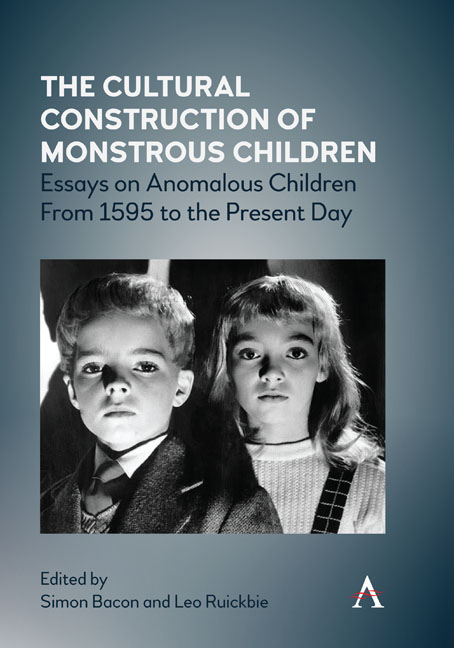 The Cultural Construction of Monstrous Children
The Cultural Construction of Monstrous Children Book contents
- Frontmatter
- Contents
- List of Illustrations
- Acknowledgements
- Introduction
- Part I Historical Case Studies
- Part II Factual Anxiety in Fictional Representations: The Undead Child
- Part III Factual Anxiety in Fictional Representations: The Monstrous Child
- Part IV Cultural Categorization in the Past, Present and Possible Future
- Notes on Contributors
- Index
Chapter Five - Imprints: Forming and Tracing the Malevolent Ghost-Child
Published online by Cambridge University Press: 20 January 2022
- Frontmatter
- Contents
- List of Illustrations
- Acknowledgements
- Introduction
- Part I Historical Case Studies
- Part II Factual Anxiety in Fictional Representations: The Undead Child
- Part III Factual Anxiety in Fictional Representations: The Monstrous Child
- Part IV Cultural Categorization in the Past, Present and Possible Future
- Notes on Contributors
- Index
Summary
Introduction: From Folklore to Fiction
The history of the ghost-child in British and New-England cultures can be traced through comparisons of the various theological debates about the child's soul and European folklore and legends influenced by those debates, as well as evidence of unusual burial practices unearthed by archaeological and anthropological studies. In a range of tales from across the British Isles (as in some other European regions), the spirits of unbaptized and/or murdered infants and young children unable to enter Heaven wandered the earth on the wind, or as ghostly lights, wailing and crying for their souls to be let in, or for their discarded bodies to be buried in consecrated ground. Although unsettling, according to Anne O’Connor dead-child ghosts in British and Irish folk tradition were predominantly seen as passive, pitiful, and vulnerable souls who needed help from the living and ‘are rarely represented as the spirits of murdered children’, even if violence or exposure was the cause of their death. These characteristics reflected their condition in philosophical and theological depictions of the underworld, from the pre-Christian imagining by Virgil to medieval and early modern conceptions of limbo, where their disembodied souls would lament their fate with ‘heart-rending sighs’. In other European regions, however, there is a history of considerably darker versions who will shriek, maim, even kill the perpetrator or passers-by who do not help them, and which have a much more tangible corporeality. Across many regions and cultures, beliefs about the ‘deviant dead’ – those who died an unnatural or ambivalent death and might rise and possibly seek revenge – characterized tales and were also reflected in burial practices, and these extended to children: More commonly this involved the exclusion of the unbaptized from consecrated ground, but there is also older archaeological and oral evidence of extreme preventative measures. For instance, Juha Pentikainen notes that, in the Ob-Ugric tradition,
it is feared that a child whom the mother has choked and hidden under a root or stone, might change into the big-eyed and wide-jawed being called ūtpi. In order to prevent the patšeχ (dead-child being resulting from a stillborn baby) from moving about, they hide the body under the roots of a hollow tree, burying it in the earth in a basket made of birch bark, with a stone on the stomach or the heart.
- Type
- Chapter
- Information
- The Cultural Construction of Monstrous ChildrenEssays on Anomalous Children from 1595 to the Present Day, pp. 91 - 108Publisher: Anthem PressPrint publication year: 2020


